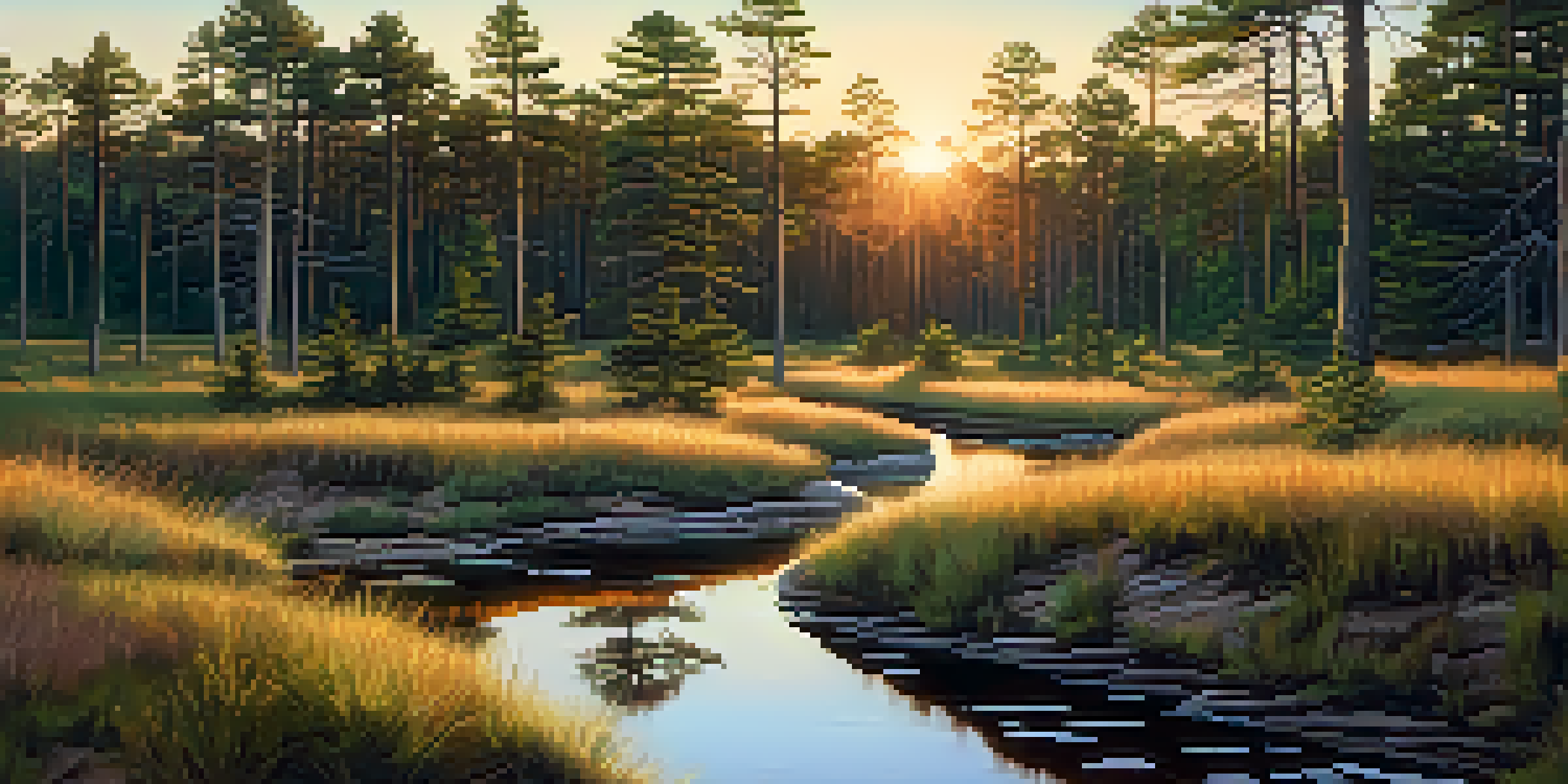A Guide to New Jersey's Wildlife and Nature Reserves

An Overview of New Jersey's Natural Landscape
New Jersey, often known for its bustling cities and beaches, is surprisingly rich in wildlife and natural beauty. With over 800,000 acres of preserved land, the state boasts a variety of ecosystems, from wetlands to forests. This diverse landscape creates a perfect habitat for numerous species of plants and animals.
In every walk with nature one receives far more than he seeks.
The state's positioning along the Atlantic Flyway makes it a crucial stop for migratory birds. As you explore the parks and reserves, you may spot everything from majestic eagles to colorful songbirds. This blend of habitats not only supports wildlife but also offers residents and visitors a chance to connect with nature.
Whether you're hiking in the Pine Barrens or exploring coastal marshes, New Jersey's natural beauty is waiting to be discovered. Each region offers unique experiences that highlight the state's ecological diversity, making it a perfect destination for nature enthusiasts.
Top Wildlife Species to Observe in New Jersey
New Jersey is home to a rich tapestry of wildlife, including over 300 species of birds, mammals, reptiles, and amphibians. Notable residents include the elusive bobcat and the iconic white-tailed deer, which can often be seen grazing in fields and forests. Birdwatchers will delight in the variety of species, including ospreys, herons, and even the rare peregrine falcon.

In addition to these larger mammals and birds, the state's wetlands are vital for amphibian populations. Frogs, toads, and salamanders thrive in these ecosystems, making them great spots for family-friendly exploration. Observing these creatures can be a fun and educational experience for both kids and adults.
New Jersey's Diverse Ecosystems
With over 800,000 acres of preserved land, New Jersey features a variety of ecosystems that support rich wildlife and plant species.
The diversity of species is a testament to New Jersey's commitment to conservation. Many reserves and parks are actively involved in protecting these animals, providing habitats where they can thrive and visitors can observe them responsibly.
Exploring the Pine Barrens: A Unique Ecosystem
The Pine Barrens, a distinctive area in southern New Jersey, is a fascinating ecosystem known for its sandy soil and pitch pine trees. This region's unique characteristics support a variety of wildlife, including the endangered New Jersey chorus frog and the rare Pine Barrens tree frog. It's truly a haven for those interested in unique flora and fauna.
The earth has music for those who listen.
Home to vast stretches of forests and wetlands, the Pine Barrens also offer numerous recreational opportunities. You can hike, bike, or kayak through its scenic trails, immersing yourself in the tranquility of nature. As you explore, you might stumble upon hidden streams and vibrant wildflowers that paint the landscape.
Visiting the Pine Barrens is like stepping into another world, one where nature reigns supreme. It’s a perfect example of how diverse New Jersey's natural reserves can be, providing a backdrop for adventure and discovery.
The Importance of the Delaware Water Gap National Recreation Area
The Delaware Water Gap National Recreation Area is a stunning example of New Jersey's natural beauty, featuring lush forests, cascading waterfalls, and the majestic Delaware River. This area offers a sanctuary for wildlife and serves as a critical watershed for the region. Visitors can enjoy hiking, fishing, and canoeing while soaking in the breathtaking views.
Wildlife is abundant here, with deer, black bears, and a variety of birds calling the area home. The diverse habitats found within the park support numerous species, making it an excellent location for wildlife observation. Early morning or late afternoon are prime times to catch a glimpse of these animals in their natural environment.
Wildlife Observation Opportunities
The state's parks and wildlife refuges provide excellent spots for observing diverse wildlife, including migratory birds and unique amphibians.
This recreation area is not only vital for biodiversity but also provides educational opportunities through guided tours and programs. Whether you're a seasoned hiker or a casual visitor, the Delaware Water Gap offers something for everyone, highlighting the importance of preserving natural spaces.
Discovering the Great Swamp National Wildlife Refuge
The Great Swamp National Wildlife Refuge is an oasis for wildlife lovers, covering over 7,000 acres of wetlands and forests. This refuge is a critical habitat for migratory birds and other wildlife, providing essential nesting and feeding grounds. It's an ideal spot for birdwatching, with numerous trails and observation platforms.
Here, visitors can witness the seasonal changes that affect the flora and fauna, from vibrant spring blooms to the stunning fall foliage. The refuge is also home to a variety of mammals, amphibians, and reptiles, making every visit a potential new discovery. Each season brings unique opportunities to observe the wildlife that thrives in this diverse environment.
The Great Swamp is dedicated to conservation and education, offering programs that engage the community in protecting wildlife. By visiting, you not only experience nature's wonders but also contribute to ongoing conservation efforts.
The Role of New Jersey's State Parks in Conservation
New Jersey's state parks play a crucial role in wildlife conservation and habitat protection. With over 50 state parks and forests, these areas provide vital ecosystems for countless species while also offering recreational opportunities. They serve as a refuge for wildlife and a place for people to connect with nature.
Each park has its own unique features, from the rugged trails of High Point State Park to the serene shores of Island Beach State Park. These diverse landscapes support various wildlife populations, making them essential for biodiversity. Exploring these parks fosters an appreciation for the natural world and encourages responsible outdoor practices.
Importance of Conservation Efforts
Engaging in wildlife observation and supporting conservation projects play a crucial role in preserving New Jersey's natural beauty and biodiversity.
Moreover, state parks often host educational programs and events that promote awareness about local wildlife and conservation efforts. By visiting these parks, you support the preservation of New Jersey’s natural resources and contribute to the sustainability of its ecosystems.
Participating in Wildlife Observation and Conservation
Engaging in wildlife observation is not only a rewarding experience but also an important part of conservation efforts. By simply observing wildlife in their natural habitats, you become an advocate for their protection. Many parks and reserves offer guided tours that educate visitors about the species they may encounter and the importance of preserving their ecosystems.
Volunteering for local conservation projects is another way to contribute. Many organizations in New Jersey actively seek volunteers to help with habitat restoration, wildlife monitoring, and educational outreach. Getting involved not only helps the environment but also enriches your connection to the natural world.

Whether you're birdwatching, participating in clean-up events, or learning about local species, your efforts can make a difference. Every small action contributes to the larger goal of sustaining New Jersey's rich wildlife and natural beauty.
Tips for Enjoying New Jersey's Wildlife Safely and Responsibly
When exploring New Jersey's wildlife and nature reserves, it's essential to prioritize safety and responsibility. Always respect wildlife by observing from a distance and avoiding feeding animals. This helps maintain their natural behaviors and keeps both you and the animals safe.
Wearing appropriate clothing and footwear is also crucial, especially when hiking in diverse terrains. Be sure to stay on marked trails to minimize your impact on the environment and protect sensitive habitats. Carrying a map or using a reliable GPS can help you navigate the parks safely.
Lastly, practicing the 'Leave No Trace' principles ensures that these beautiful areas remain pristine for future visitors. By planning ahead and being mindful of your actions, you can enjoy all that New Jersey's wildlife and nature reserves have to offer while helping to protect them.